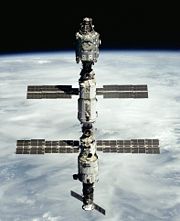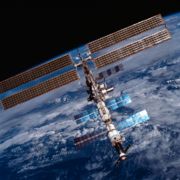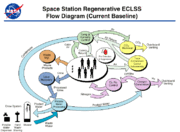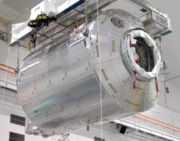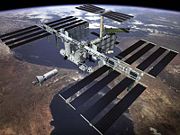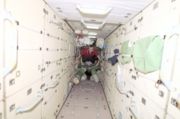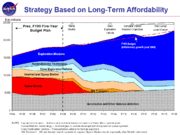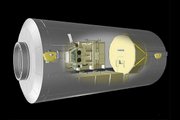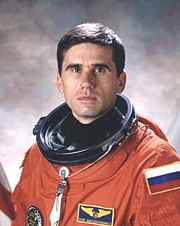International Space Station
2008/9 Schools Wikipedia Selection. Related subjects: Engineering; Space transport
| International Space Station | ||
|---|---|---|
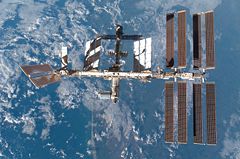 |
||
| The International Space Station as seen from the departing Space Shuttle Atlantis on STS-122. | ||
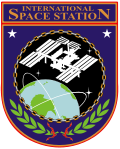 |
||
| ISS Insignia | ||
| Station statistics | ||
| Call sign: | Alpha | |
| Crew: | 3 | |
| Launch: | 1998-Present | |
| Launch pad: | Kennedy Space Centre | |
| Mass: | 245,735 kg (540, 617 lb) ( 2008- 02-15) 471,736 kg (1,040,000 lb) upon completion |
|
| Length: | 58.2 m (191 ft) along truss ( 2007- 02-22) |
|
| Width: | 44.5 m (146 ft) from Destiny to Zvezda 73.15 m (240 ft) span of solar arrays ( 2007- 02-22) |
|
| Height: | 27.4 m (90 ft) ( 2007- 02-22) |
|
| Living volume: | 424.75 m³ (15,000 ft³) |
|
| Atmospheric pressure: | 101.3 kPa (29.91 inHg) | |
| Perigee: | 331.0 km (183.2 nmi) ( 2008- 02-15) |
|
| Apogee: | 339.0 km (184.6 nmi) ( 2008- 02-15) |
|
| Orbit inclination: | 51.6410 degrees ( 2008- 02-15) |
|
| Typical orbit altitude: | 340.5 km (183.86 nmi) | |
| Average speed: | 27,743.8 km/h (17,239.2 mi/h, 7706.6 m/s) |
|
| Orbital period: | 91.34 minutes | |
| Orbits per day: | 15.78224218 ( 2008- 02-15) |
|
| Days in orbit: | 3491 (11 June 2008) | |
| Days occupied: | 2780 (11 June 2008) | |
| Number of orbits: | 55095 (11 June 2008) | |
| Distance travelled: | 2,000,000,000 km (1,100,000,000 nmi) |
|
| Statistics as of November 20, 2007 (unless noted otherwise). | ||
| References: | ||
| Configuration | ||
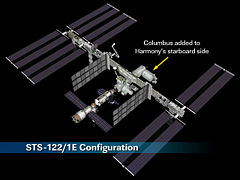 |
||
| International Space Station current elements | ||
| International Space Station | ||
The International Space Station (ISS) is a research facility currently being assembled in space. The on-orbit assembly of ISS began in 1998. The space station is in a low Earth orbit and can be seen from Earth with the naked eye: it has an altitude of 350-460 km (189-248 statute miles) above the surface of the Earth, and travels at an average speed of 27,700 km (17,210 statute miles) per hour, completing 15.77 orbits per day. The ISS is a joint project among the space agencies of the United States ( NASA), Russia ( RKA), Japan ( JAXA), Canada ( CSA) and several European countries (ESA).
The Brazilian Space Agency (AEB, Brazil) participates through a separate contract with NASA. The Italian Space Agency similarly has separate contracts for various activities not done in the framework of ESA's ISS works (where Italy also fully participates). China has reportedly expressed interest in the project, especially if it is able to work with the RKA. The Chinese are not currently involved, however.
The ISS is a continuation of what began as the U.S. Space Station Freedom, the funding for which was cut back severely. It represents a merger of Freedom with several other previously planned space stations: Russia's Mir 2, the planned European Columbus and Kibo, the Japanese Experiment Module. The projected completion date is 2010, with the station remaining in operation until around 2016. As of 2008, the ISS is already larger than any previous space station.
The ISS has been continuously inhabited since the first resident crew entered the station on November 2, 2000, thereby providing a permanent human presence in space. The crew of Expedition 16 are currently aboard. The station is serviced primarily by Russian Soyuz and Progress spacecraft and by U.S. Space Shuttle orbiters. At present the station has a capacity for a crew of three. Early crew members all came from the Russian and U.S. space programs. German ESA astronaut Thomas Reiter joined the Expedition 13 crew in July 2006, becoming the first crew member from another space agency. The station has, however, been visited by astronauts from 15 countries. The ISS was also the destination of the first five space tourists.
Origins
In the early 1980s, NASA planned Space Station Freedom as a counterpart to the Soviet Salyut and Mir space stations. It never left the drawing board and, with the end of the Soviet Union and the Cold War, it was cancelled. The end of the space race prompted the U.S. administration officials to start negotiations with international partners Europe, Russia, Japan and Canada in the early 1990s in order to build a truly international space station. This project was first announced in 1993 and was called Space Station Alpha. It was planned to combine the proposed space stations of all participating space agencies: NASA's Space Station Freedom, Russia's Mir-2 (the successor to the Mir Space Station, the core of which is now Zvezda) and ESA's Columbus that was planned to be a stand-alone spacelab.
The first section, the Zarya Functional Cargo Block, was put in orbit in November 1998 on a Russian Proton rocket. Two further pieces (the Unity Module and Zvezda service module) were added before the first crew, Expedition 1, was sent. Expedition 1 docked to the ISS on November 2, 2000, and consisted of U.S. astronaut William Shepherd and two Russian cosmonauts, Yuri Gidzenko and Sergei Krikalev.
Assembly
The assembly of the International Space Station is a major aerospace engineering endeavor. When assembly is complete the ISS will have a pressurized volume of approximately 1,000 cubic meters. Assembly began in November 1998 with the launch of Zarya -- the first ISS module -- on a Proton rocket, and as of 2008 assembly is on-going.
Two weeks after Zarya was launched, the STS-88 shuttle mission followed, bringing Unity, the first of three node modules, and connecting it to Zarya. This bare 2-module core of the ISS remained unmanned for the next one and a half years, until in July 2000 the Russian module Zvezda was added, allowing a maximum crew of two astronauts or cosmonauts to be on the ISS permanently.
Pressurized modules
The ISS is currently under construction, and will eventually consist of fourteen pressurized modules with a combined volume of around 1,000 cubic metres. These modules include laboratories, docking compartments & airlocks, nodes and living quarters, eight of which are already in orbit, with the remaining six awaiting launch on the ground. Each module is launched either by Space Shuttle, Proton rocket or Soyuz rocket, and is listed below along with its purpose, launch date and mass.
| For more information about the modules, visit the module pages linked on the table below. |
| Module | Launch date | Launch vehicle | Docking date | Mass (kg) | Assembly flight | Purpose | Isolated View | Station View |
|---|---|---|---|---|---|---|---|---|
| Zarya (FGB) |
1998- 11-20 | Proton-K | N/A | 19,323 kg (42,600 lb) | 1A/R | Provided electrical power, storage, propulsion, and guidance during initial assembly, now serves as a storage module (both inside the pressurized section and in the externally mounted fuel tanks). |  |
 |
| Unity (Node 1) |
1998- 12-04 | Space Shuttle Endeavour, STS-88 | 1998- 12-07 | 11,612 kg (25,600 lb) | 2A | First American node, connecting the American section of the station to the Russian section (via PMA-1). Provides berthing locations for the Z0 truss, Quest airlock, Destiny laboratory and Node 3. |  |
 |
| Zvezda (Service Module) |
2000- 07-12 | Proton-K | 2000- 07-26 | 19,051 kg (42,000 lb) | 1R | Station service module, providing main living quarters for resident crews, environmental systems and attitude & orbit control, in addition to docking locations for Soyuz spacecraft, Progress spacecraft and the Automated Transfer Vehicle. The addition of the module rendered the ISS permanently habitable for the first time. |  |
 |
| Destiny (US Laboratory) |
2001- 02-07 | Space Shuttle Atlantis, STS-98 | 2001- 02-10 | 14,515 kg (32,000 lb) | 5A | Primary research facility for American payloads aboard the ISS, also providing environmental systems and living quarters to the station. |  |
 |
| Quest (Joint Airlock) |
2001- 07-12 | Space Shuttle Atlantis, STS-104 | 2001- 07-14 | 6,064 kg (13,369 lb) | 7A | Primary airlock for the ISS, hosting spacewalks with both American EMU and Russian Orlan spacesuits. |  |
 |
| Pirs (Docking Compartment) |
2001- 09-14 | Soyuz-U | 2001- 09-16 | 3,630 kg (8,003 lb) | 4R | Provides the ISS with additional docking ports for Soyuz & Progress spacecraft, and allows egress and ingress for spacewalks by cosmonauts using Russian Orlan spacesuits, in addition to providing storage space for these spacesuits. |  |
 |
| Harmony (Node 2) |
2007- 10-23 | Space Shuttle Discovery, STS-120 | 2007- 11-14 | 13,608 kg (30,001 lb) | 10A | The "utility hub" of the ISS. Node 2 contains four racks that provide electrical power, bus electronic data, and act as a central connecting point for several other components via its six Common Berthing Mechanisms (CBMs). The European Columbus is currently berthed to Harmony. The Japanese Kibō laboratories will also be berthed to Harmony when it is launched. In addition, the Harmony module serves as a berthing port for the Multi-Purpose Logistics Modules during space shuttle logistics flights. |  |
 |
| Columbus (European Laboratory) |
2008- 02-07 | Space Shuttle Atlantis, STS-122 | 2008- 02-11 | 12,800 kg (28,219 lb) | 1E | Primary research facility for European payloads aboard the ISS, providing ten International Standard Payload Racks and mounting locations for external experiments. | Image:Columbus arm.jpg |  |
| Unlaunched modules | ||||||||
| Experiment Logistics Module (JEM-ELM) |
NET 2008- 03-11 | Space Shuttle Endeavour, STS-123 | TBD | 4,200 kg (9,259 lb) | 1J/A | Not yet launched. Part of the Kibō Japanese Experiment Module laboratory, the ELM provides storage and transportation facilities to the laboratory, with a pressurized section to serve internal payloads and an unpressurized section to serve external payloads. |  |
|
| Japanese Pressurized Module (JEM-PM) |
NET 2008- 04-24 | Space Shuttle Discovery, STS-124 | TBD | 15,900 kg (35,053 lb) | 1J | Not yet launched. Part of the Kibō Japanese Experiment Module laboratory, the PM is the core module of Kibō to which the ELM & Exposed Facility are berthed and contains ten International Standard Payload Racks. |  |
|
| Multipurpose Laboratory Module | December 2008 | Proton-K | TBD | 21,300 kg (46,958 lb) | 3R | Not yet launched. The MLM will be Russia's primary research module as part of the ISS, and will be used for experiments, docking and cargo logistics. It will also serve as a crew work and rest area, and will also be equipped with a backup attitude control system that can be used to control the station's attitude. |  |
|
| Docking Cargo Module | 2010 | Space Shuttle Endeavour, STS-131 | TBD | 4,700 kg (10,362 lb) | ULF4 | Not yet launched. The final Russian component of the ISS, the DCM will be used for docking and cargo storage aboard the station. | ||
| Node 3 | 2010 | Space Shuttle Discovery, STS-132 | TBD | 14,311 kg (31,550 lb) | 20A | Not yet launched. The last of the station's US nodes, Node 3 will contain the most advanced life support systems ever flown in space, providing systems to recycle waste water for crew use and generate oxygen for the crew to breathe. The node also provides four berthing locations for more attached pressurized modules or crew transportation vehicles, in addition to the permanent berthing location for the station's Cupola. |  |
|
| Cupola | 2010 | Space Shuttle Discovery, STS-132 | TBD | 1,800 kg (3,968 lb) | 20A | Not yet launched. The Cupola is an observatory module that will provide ISS crew members with a direct view of robotic operations and docked spacecraft, as well as an observation point for watching the Earth. The module will come equipped with robotic workstations for operating the SSRMS and shutters to prevent its windows from being damaged by micrometeorites. The Cupola will be the last station component to be berthed in its permanent location. |  |
 |
Major ISS systems
Power supply
The source of electrical power for the ISS is the sun: light is converted into electricity through the use of solar panels. Before assembly flight 4A (shuttle mission STS-97, November 30, 2000) the only power source was the Russian solar panels attached to the Zarya and Zvezda modules: the Russian segment of the station uses 28 volts dc (like the Shuttle). In the rest of the station, electricity is provided by the solar cells attached to the truss at a voltage ranging from 130 to 180 volts dc. The power is then stabilized and distributed at 160 volts dc and then converted to the user-required 124 volts dc. Power can be shared between the two segments of the station using converters, and this feature is essential since the cancellation of the Russian Science Power Platform: the Russian segment will depend on the U.S. built solar arrays for power supply.
Using a high-voltage (130 to 160 volts) distribution line in the U.S. part of the station led to smaller power lines and thus weight savings.
The solar array normally tracks the sun to maximize the amount of solar power. The array is about an acre in area and 190 feet (58 m) long. In the fully-complete configuration, the solar arrays track the sun in each orbit by rotating the alpha gimbal; while the beta gimbal adjusts for the angle of the sun from the orbital plane. (However, until the main truss structure was brought up, the arrays were in a temporary position perpendicular to the final orientation, and in this configuration, as shown in the image to the right, the beta gimbal was used for the main solar tracking.) Another slightly different tracking option, Night Glider mode, can be used to reduce the drag slightly by orienting the solar arrays edgewise to the velocity vector.
Life support
The ISS Environmental Control and Life Support System provides or controls elements such as atmospheric pressure, oxygen levels, water, and fire extinguishing, among other things. The Elektron system generates oxygen aboard the station. The highest priority for the life support system is the ISS atmosphere, but the system also collects, processes, and stores waste and water produced and used by the crew. For example, the system recycles fluid from the sink, shower, urine, and condensation. Activated charcoal filters are the primary method for removing byproducts of human metabolism from the air.
Attitude control
The attitude (orientation) of the station is maintained by either of two mechanisms. Normally, a system using several control moment gyroscopes (CMGs) keeps the station oriented, i.e. with Destiny forward of Unity, the P truss on the port side and Pirs on the earth-facing (nadir) side. When the CMG system becomes saturated, it can lose its ability to control station attitude. If this happens, the Russian Attitude Control System can take over, using thrusters to maintain station attitude and allowing the CMG system to desaturate. This has happened automatically as a safety measure, as happened for example during Expedition 10. When a shuttle orbiter is docked to the station, it can also be used to maintain station attitude. This procedure was used during STS-117 as the S3/S4 truss was being installed.
Altitude control
The ISS is maintained at an orbit from a minimum altitude limit of 278 km to a maximum limit of 460 km. The normal maximum limit is 425 km to allow Soyuz rendezvous missions. Because ISS is constantly falling due to minute atmospheric drag and gravity gradient effects, it needs to be boosted to a higher altitude several times each year. A graph of altitude over time shows that it drifts down almost 2.5 km per month. The boosting can be performed by two boosters on the Zvezda module, a docked Space Shuttle, or by a Progress resupply vessel and takes approximately two orbits (three hours) in which it is boosted several kilometers higher. While it is being built the altitude is relatively low so that it is easier to fly the Space Shuttle with its big payloads to the space station.
Scientific research
One of the main goals of the ISS is to provide a place to conduct experiments that require one or more of the unusual conditions present on the station. The main fields of research include biology (including biomedical research and biotechnology), physics (including fluid physics, materials science, and quantum physics), astronomy (including cosmology), and meteorology. The 2005 NASA Authorization Act designated the U.S segment of the International Space Station as a national laboratory with a goal to increase the utilization of the ISS by other Federal entities and the private sector. As of 2007, little experimentation other than the study of the long-term effects of microgravity on humans has taken place. With four new research modules set to arrive at the ISS by 2010, however, more specialized research is expected to begin.
Scientific ISS modules
The Destiny Laboratory Module is the main research facility currently aboard the ISS. Produced by NASA and launched in February 2001, it is a research facility for general experiments. The Columbus module is another research facility, designed by the ESA for the ISS. Its purpose is to facilitate scientific experiments, and was launched aboard Space Shuttle Atlantis, during mission STS-122 on February 7, 2008 and installed on February 11, 2008. It should provide a generic laboratory as well as ones specifically designed for biology, biomedical research, and fluid physics. There are also a number of planned expansions that will be implemented to study quantum physics and cosmology. The Japanese Experiment Module, also known as Kibō, is scheduled to be in space after the STS-127 launch in or around January, 2009. It is being developed by JAXA in order to function as an observatory and to measure various astronomical data. The ExPRESS Logistics Carrier, developed by NASA, is set to be launched for the ISS with the STS-129 mission, which is expected to take place no earlier than September 11, 2009. It will allow experiments to be deployed and conducted in the vacuum of space and will provide the necessary electricity and computing to locally process data from experiments. The Multipurpose Laboratory Module, created by the RKA, is expected to launch for the ISS in late 2009. It will supply the proper resources for general microgravity experiments.
A couple of planned research modules have been cancelled, including the Centrifuge Accommodations Module (used to produce varying levels of artificial gravity) and the Russian Research Module (used for general experimentation). Several planned experiments, such as the Alpha Magnetic Spectrometer, have been cancelled as well.
Areas of research
There are a number of plans to study biology on the ISS. One goal is to improve understanding of the effect of long-term space exposure on the human body. Subjects such as muscle atrophy, bone loss, and fluid shifts are studied with the intention to utilize this data so space colonization and lengthy space travel can become feasible. The effect of near-weightlessness on evolution, development and growth, and the internal processes of plants and animals are also studied. In response to recent data suggesting that microgravity enables the growth of three-dimensional human body-like tissues and that unusual protein crystals can be formed in space, NASA has indicated a desire to investigate these phenomena.
NASA would also like to study prominent problems in physics. The physics of fluids in microgravity are not completely understood, and researchers would like to be able to accurately model fluids in the future. Additionally, since fluids in space can be combined nearly completely regardless of their relative weights, there is some interest in investigating the combination of fluids that would not mix well on Earth. By examining reactions that are slowed down by low gravity and temperatures, scientists also hope to gain new insight concerning states of matter (specifically in regards to superconductivity).
Additionally, researchers hope to examine combustion in the presence of less gravity than on Earth. Any findings involving the efficiency of the burning or the creation of byproducts could improve the process of energy production, which would be of economic and environmental interest. Scientists plan to use the ISS to examine aerosols, ozone, water vapor, and oxides in Earth's atmosphere as well as cosmic rays, cosmic dust, anti-matter, and dark matter in the Universe.
The long-term goals of this research are to develop the technology necessary for human-based space and planetary exploration and colonization (including life support systems, safety precautions, environmental monitoring in space, etc.), new ways to treat diseases, more efficient methods of producing materials, more accurate measurements that would be impossible to achieve on Earth, and a more complete understanding of the Universe.
Future of the ISS
NASA Administrator Michael D. Griffin says the International Space Station has a role to play as NASA moves forward with a new focus for the manned space program, which is to go out beyond Earth orbit for purposes of human exploration and scientific discovery. "The International Space Station is now a stepping stone on the way," says Griffin, "rather than being the end of the line". He says ISS crews not only will continue to learn how to live and work in space but also will learn how to build hardware that can survive and function for the years required to make the round-trip voyage from Earth to Mars.
Major incidents
2001 – 6A Anomaly
Around the time Dennis Tito became the first space tourist, assembly flight 6A was taking place. On April 25, 2001, the Memory Storage Devices (MSDs), which comprised Disk Drive Cartridges (DDCs) on the ISS main computers (C&C MDMs) all failed nearly simultaneously. The station's MDMs now use solid state mass memory units (SSMMUs) in place of traditional disk drive cartridges (DDCs).
2003 – Columbia disaster
The Space Shuttle Columbia disaster on February 1, 2003, the following two-and-a-half-year suspension of the U.S. Space Shuttle program, followed in turn by another one-year suspension following STS-114, all resulted in some uncertainty about the future of the ISS. All crew exchanges between Feb. 2003 and July 2006 were carried out solely using the Russian Soyuz spacecraft. (STS-114 in July 2005 was a logistics-only visit). Starting with Expedition 7, two-astronaut caretaker crews were launched in contrast to the previously launched crews of three. Because the ISS had not been visited by a shuttle for an extended period, a larger than planned amount of waste accumulated, temporarily hindering station operations in 2004. However, Progress transports and the STS-114 shuttle flight took care of this problem.
2006 – Smoke problem
On September 18, 2006, the Expedition 13 crew activated a smoke alarm in the Russian segment of the International Space Station when fumes from one of the three oxygen generators triggered momentary fear about a possible fire. Flight engineer Jeffrey Williams reported an unusual smell, but officials said there was no fire and the crew was not in any danger.
The crew initially reported smoke in the cabin, as well as a smell. It was later found to be caused by a leak of potassium hydroxide from an oxygen vent. The equipment was turned off. Potassium hydroxide is odorless and the smell reported by Williams more likely was associated with an overheated rubber gasket in the Elektron system.
In any case, the station's ventilation system was shut down to prevent the spread of smoke or contaminants through the rest of the lab complex. A charcoal air filter was put in place to help scrub the atmosphere of any lingering potassium hydroxide fumes. The space station's program manager said the crew never donned gas masks, but as a precaution put on surgical gloves and masks to prevent contact with any contaminants.
On November 2, 2006 the payload brought by the Russian Progress M-58 allowed the crew to repair the Elektron using spare parts.
2007 – Computer failure
On June 14, 2007 during Expedition 15 and flight day 7 of STS-117's visit to ISS, a computer malfunction on the Russian segments at 06:30 UTC left the station without thrusters, oxygen generation, carbon dioxide scrubber, and other environmental control systems, and caused the temperature on the station to rise. A successful restart of the computers resulted in a false fire alarm that woke the crew at 11:43 UTC. The two computer systems (command and navigation) are each composed of three computers. Each computer is referred to as a "lane".
By June 15, the primary Russian computers were back online, and talking to the US side of the station by bypassing a circuit. Secondary systems were still offline, and further work was needed. NASA reported that without the computer that controls the oxygen levels, the station had 56 days of oxygen available.
By the afternoon of June 16, ISS Program Manager Michael Suffredini confirmed that all six computers governing command and navigation systems for Russian segments of the station, including two thought to have failed, were back online, and would be tested over several days. The cooling system was the first system brought back online. NASA suggested that the overcurrent protection circuits designed to safeguard each computer from power spikes were at fault, and may have been tripped due to increased interference, or "noise," from the station's plasma environment related to the addition of the new starboard trusses and solar arrays. Troubleshooting of the failure by the ISS crew found that the root cause was condensation inside the electrical connectors, leading to a short-circuit that triggered the "power off" command line leading to all three of the redundant processing units. This was initially a concern, because the European Space Agency uses the same computer systems, supplied by EADS Astrium Space Transportation, for the Columbus Laboratory Module and the Automated Transfer Vehicle. Once the root cause was understood, plans were implemented to avoid the problem in the future.
2007 – Torn solar panel
On October 30, 2007 during Expedition 16 and flight day 7 of STS-120's visit to ISS, following the reposition of the P6 truss segment, ISS and Space Shuttle Discovery crew members began the deployment of the trusses two solar arrays. The first array deployed without incident, and the second array deployed approximately 80% before astronauts noticed a 2 1/2 foot tear. The arrays had been deployed in earlier phases of the space station's construction, and the retraction necessary to move the truss to its final position had gone less smoothly than planned.
A second, smaller tear was noticed upon further inspection, and the mission's planned spacewalks were completely replanned in mere days to devise a repair. On Saturday November 3, spacewalker Scott Parazynski assisted by Douglas Wheelock fixed the torn panels using makeshift "cufflinks" and riding on the end of the space shuttle's boom inspection arm; the first ever spacewalker to do so. The spacewalk was regarded as significantly more dangerous than most due to the possibility of shock from the electricity generating solar arrays, the unprecedented usage of the shuttle boom arm, and the lack of spacewalk planning and training for the impromptu procedure. Parazynski was however, able to repair the damage as planned and the repaired array was fully deployed.
Visiting spacecraft
- American (NASA) Space Shuttle - resupply vehicle, assembly and logistics flights and crew rotation (to be retired in 2010)
- Russian (Roskosmos) Soyuz spacecraft - crew rotation and emergency evacuation, replaced every 6 months
- Russian (Roskosmos) Progress spacecraft - resupply vehicle
Planned
- European (ESA) Automated Transfer Vehicle (ATV) ISS resupply spacecraft (scheduled for March 2008)
- Japanese (JAXA) H-II Transfer Vehicle (HTV) resupply vehicle for Kibo module (scheduled for 2009)
- American (NASA) Orion for possible crew rotation and as resupply transporter (officially scheduled for 2014)
Proposed
- SpaceX Dragon for NASA Commercial Orbital Transportation Services (Scheduled for 2009)
- Russian (Roskosmos) Space Shuttle Kliper for possible crew rotation and as resupply transporter (scheduled for 2012)
- European-Russian Crew Space Transportation System (Soyuz-derived) crew rotation and resupply spacecraft (scheduled for 2014)
An additional spacecraft, the K-1 Vehicle manufactured by Rocketplane Kistler, was proposed as part of the NASA Commercial Orbital Transportation Services program, and was scheduled to fly in 2009. On October 18, 2007, NASA discontinued its agreement with Rocketplane Kistler, and announced that the remaining $175 million commitment to the project would be made available to other companies.
Expeditions
All permanent station crews are named "Expedition n", where n is sequentially increased after each expedition. Expeditions (also called "Increments") have an average duration of half a year.
The International Space Station is the most-visited spacecraft in the history of space flight. As of October 26, 2007, it has had 196 (non-distinct) visitors. Mir had 137 (non-distinct) visitors (See Space station). The number of distinct visitors of the ISS is 144 .
|
|||||||||||||
Legal aspects
Agreement
The legal structure that regulates the space station is multi-layered. The primary layer establishing obligations and rights between the ISS partners is the Space Station Intergovernmental Agreement (IGA), an international treaty signed on January 28, 1998 by fifteen governments involved in the Space Station project. The ISS consists of the United States, Canada, Japan, the Russian Federation, and eleven Member States of the European Space Agency (Belgium, Denmark, France, Germany, Italy, The Netherlands, Norway, Spain, Sweden, Switzerland and the United Kingdom). Article 1 outlines its purpose:
This Agreement is a long term international co-operative framework on the basis of genuine partnership, for the detailed design, development, operation, and utilisation of a permanently inhabited civil Space Station for peaceful purposes, in accordance with international law.
The IGA sets the stage for a second layer of agreements between the partners referred to as 'Memoranda of Understanding' (MOUs), of which four exist between NASA and each of the four other partners. There are no MOUs between ESA, Roskosmos, CSA and JAXA due to the fact that NASA is the designated manager of the ISS. The MOUs are used to describe the roles and responsibilities of the partners in more detail.
A third layer consists of bartered contractual agreements or the trading of the partners' rights and duties, including the 2005 commercial framework agreement between NASA and Roskosmos that sets forth the terms and conditions under which NASA purchases seats on Soyuz crew transporters and cargo capacity on unmanned Progress transporters.
A fourth legal layer of agreements implements and supplements the four MOUs further. Notably among them is the ISS code of conduct, setting out criminal jurisdiction, anti-harassment and certain other behaviour rules for ISS crewmembers.
Utilization
There is no fixed percentage of ownership for the whole space station. Rather Article 5 of the IGA sets forth that each partner shall retain jurisdiction and control over the elements it registers and over personnel in or on the Space Station who are its nationals. Therefore, for each ISS module only one partner retains sole ownership. Still, the agreements to use the space station facilities are more complex.
The three planned Russian segments Zvezda, the Multipurpose Laboratory Module and the Russian Research Modules are made and owned by Russia, which, as of today, also retains its current and prospective usage ( Zarya, although constructed and launched by Russia, has been paid for and is officially owned by NASA). In order to use the Russian parts of the station, the partners use bilateral agreements (third and fourth layer of the above outlined legal structure). The rest of the station, (the U.S., the European and Japanese pressurized modules as well as the truss and solar panel structure and the two robotic arms) has been agreed to be utilized as follows (% refers to time that each structure may be used by each partner):
- Columbus: 51% for ESA, 49% for NASA and CSA (CSA has agreed with NASA to use 2.3% of all non-Russian ISS structure)
- Kibo: 51% for JAXA, 49% for NASA and CSA (2.3%)
- Destiny Lab: 100% for NASA and CSA (2.3%) as well as 100% of the truss payload accommodation
- Crew time and power from the solar panel structure, as well as rights to purchase supporting services (upload/download and communication services) 76.6% for NASA, 12.8% for JAXA, 8.3% for ESA and 2.3% for CSA
Costs
The ISS has been, as of today, far more expensive than originally anticipated. The ESA estimates the overall cost from the start of the project in the late 1980s to the prospective end in 2010 to be in the region of $130 billion (€100 billion or £65.3 billion).
Giving a precise cost estimate for the ISS is, however, not straightforward; it is, for instance, hard to determine which costs should actually be attributed to the ISS program or how the Russian contribution should be measured, as the Russian space agency runs at considerably lower USD costs than the other partners.
NASA
Overview
The overall majority of costs for NASA are incurred by flight operations and expenses for the overall management of the ISS. Costs for initially building the U.S. portion of the ISS modules and external structure on the ground and construction in space as well as crew and supply flights to the ISS do account for far less than the general operating costs (see annual budget allocation below).
NASA does not include the basic Space Shuttle program costs in the expenses incurred for the ISS program, despite the fact that the Space Shuttle has been nearly exclusively used for ISS construction and supply flights since December 1998.
NASA's 2007 budget request lists costs for the ISS (without Shuttle costs) as $25.6 billion for the years 1994 to 2005. For each of 2005 and 2006 about $1.7 to 1.8 billion are allocated to the ISS program. The annual expenses will increase until 2010 when they will reach $2.3 billion and should then stay at the same level, however inflation-adjusted, until 2016, the defined end of the program. NASA has allocated between $300 and 500 million for program shutdown costs in 2017.
2005 ISS budget allocation
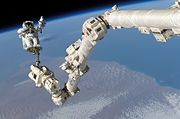
The $1.8 billion expensed in 2005 consisted of:
- Development of new hardware: $70 million were allocated to core development, for instance development of systems like navigation, data support or environmental.
- Spacecraft Operations: $800 million consisting of $125 million for each of software, extravehicular activity systems, and logistics and maintenance. An additional $150 million is spent on flight, avionics and crew systems. The rest of $250 million goes to overall ISS management.
- Launch and Mission operations: Although the Shuttle launch costs are not considered part of the ISS budget, mission and mission integration ($300 million), medical support ($25 million) and Shuttle launch site processing ($125 million) is within the ISS budget.
- Operations Program Integration: $350 million was spent on maintaining and sustaining U.S. flight and ground hardware and software to ensure integrity of the ISS design and the continuous, safe operability.
- ISS cargo/crew: $140 million was spent for purchase of supplies, cargo and crew capability for Progress and Soyuz flights.
Shuttle costs as part of ISS costs
Only costs for mission and mission integration and launch site processing for the 33 ISS-related Shuttle flights are included in NASA's ISS program costs. Basic costs of the Shuttle program are, as mentioned above, not considered part of the overall ISS costs by NASA, because the Shuttle program is considered an independent program aside from the ISS. Since December 1998 the Shuttle has, however, been used nearly exclusively for ISS flights (since the first ISS flight in December 1998, until October 2007 only 5 flights out of 28 flights have not been to the ISS, and only the planned Hubble Space Telescope servicing mission in 2008 will not be ISS-related out of 13 planned missions until the end of the Space Shuttle program in 2010).
Shuttle program costs during ISS operations from 1999 to 2005 (disregarding the first ISS flight in December 1998) have amounted to approximately $24 billion (1999: $3,028.0 million, 2000: $3,011.2 million, 2001: $3,125.7 million, 2002: $3,278.8 million, 2003: $3,252.8 million, 2004: $3,945.0 million, 2005: $4,319.2 million). In order to derive the ISS-related costs, expenses for non-ISS flights need to be subtracted, which amount to 20% of the total or about $5 billion. For the years 2006-2011 NASA projects another $20.5 billion in Space Shuttle program costs (2006: $4,777.5 million, 2007: $4,056.7 million, 2008: $4,087.3 million, 2009: $3,794.8 million, 2010: $3,651.1 million and 2011: $146.7 million). If the Hubble servicing mission is excluded from those costs, ISS-related costs will be approximately $19 billion for Shuttle flights from 2006 until 2011. In total, ISS-related Space Shuttle program costs will therefore be approximately $38 billion.
Overall ISS costs for NASA
Assuming NASA's projections of average costs of $2.5 billion from 2011 to 2016 and the end of spending money on the ISS in 2017 (about $300-500 million) after shutdown in 2016 are correct, the overall ISS project costs for NASA from the announcement of the program in 1993 to its end will be about $53 billion (25.6 billion for the years 1994-2005 and about 27 to 28 billion for the years 2006-2017).
There have also been considerable costs for designing Space Station Freedom in the 1980s and early 1990s, before the ISS program started in 1993. Plans of Space Station Freedom were reused for the International Space Station.
To sum up, although the actual costs NASA views as connected to the ISS are only half of the $100 billion figure often cited in the media, if combined with basic program costs for the Shuttle and the design of the ISS' precursor project Space Station Freedom, the costs reach $100 billion for NASA alone.
ESA
ESA calculates that its contribution over the 30 year lifetime of the project will be €8 billion. The costs for the Columbus Laboratory total more than €1 billion already, costs for ATV development total several hundred million and considering that each Ariane 5 launch costs around €150 million, each ATV launch will incur considerable costs as well. In addition ESA has established the Columbus Control Centre in the South of Germany in order to control the Columbus Laboratory.
JAXA
The development of the Kibo Laboratory, JAXA's main contribution to the ISS, has cost about 325 billion yen (about $2.8 billion). In the year 2005, JAXA allocated about 40 billion yen (about 350 million USD) to the ISS program. The annual running costs for Kibo will total around $350 to 400 million. In addition JAXA has committed itself to develop and launch the HTV-Transporter, for which development costs total nearly $1 billion. In total, over the 24 year lifespan of the ISS program, JAXA will contribute well over $10 billion to the ISS program.
Roskosmos
A considerable part of the Russian Space Agency's budget is used for the ISS. Since 1998 there have been over two dozen Soyuz and Progress flights, the primary crew and cargo transporters since 2003. The question of how much Russia spends on the station (measured in USD), is, however, not easy to answer. The two modules currently in orbit are derivatives of the Mir program and therefore development costs are much lower than for other modules. In addition, the exchange rate between ruble and USD is not adequately giving a real comparison to what the costs for Russia really are.
CSA
Canada, whose main contribution to the ISS is the Canadarm2, estimates that through the last 20 years it has contributed about C$1.4 billion to the ISS. Canada has continued to be a leader and vital member of ISS through the past ten years and continues to play a major role in the ISS.
Criticism
"NASA must complete the ISS so it can be dropped into the ocean on schedule in finished form." - Robert L. Park
The ISS and NASA have been the targets of varied criticism over the years. Critics contend that the time and money spent on the ISS could be better spent on other projects—whether they be robotic spacecraft missions, space exploration, investigations of problems here on Earth, or just tax savings. Some critics, like Bob Park, argue that very little scientific research was convincingly planned for the ISS in the first place. They also argue that the primary feature of a space-based laboratory is its microgravity environment, which can usually be studied more cheaply with a " vomit comet" (that is, an aircraft which flies in parabolic arcs.)
Two of the most ambitious ISS projects to date—the Alpha Magnetic Spectrometer and the Centrifuge Accommodations Module—have both been cancelled due to the prohibitive costs NASA faces in simply completing the ISS. As a result, the research done on the ISS is generally limited to experiments which do not require any specialized apparatus. For example, in the first half of 2007, ISS research dealt primarily with human biological responses to being in space, covering topics like kidney stones, circadian rhythm, and the effects of cosmic rays on the nervous system. Critics tend to believe that this sort of research is of little practical value, since space exploration is today almost universally done by robots.
Other critics have attacked the ISS on some technical design grounds:
- Jeff Foust argued that the ISS requires too much maintenance, especially by risky, expensive EVAs;
- The Astronomical Society of the Pacific has mentioned that its orbit is rather highly inclined, which makes Russian launches cheaper, but US launches more expensive. This was intended as a design point, to encourage Russian involvement with the ISS—and Russian involvement saved the project from abandonment in the wake of the Space Shuttle Columbia disaster—but the choice may have increased the costs of completing the ISS substantially.
In response to some of these criticisms, advocates of manned space exploration say that criticism of the ISS project is short-sighted, and that manned space research and exploration have produced billions of dollars' worth of tangible benefits to people on Earth. Jerome Schnee estimated that the indirect economic return from spin-offs of human space exploration has been many times the initial public investment. A review of the claims by the Federation of American Scientists argued that NASA's rate of return from spin-offs is actually very low, except for aeronautics work that has led to aircraft sales.
Critics also say that NASA is often casually credited with "spin-offs" (such as Velcro and portable computers) that were developed independently for other reasons. NASA maintains a list of spin-offs from the construction of the ISS, as well as from work performed on the ISS. However, NASA's official list is much narrower and more arcane than dramatic narratives of billions of dollars of spin-offs.
It is therefore debatable whether the ISS, as distinct from the wider space program, will be a major contributor to society. Some advocates argue that apart from its scientific value, it is an important example of international cooperation. Others claim that the ISS is an asset that, if properly leveraged, could allow more economical manned Lunar and Mars missions. Either way, advocates argue that it misses the point to expect a hard financial return from the ISS; rather, it is intended as part of a general expansion of spaceflight capabilities.
Sightings
Due to the size of the International Space Station, which is the size of an American football field, and particularly due to the large reflective area offered by its solar panels, ground based observation of the station is possible with the naked eye. In many cases the station is one of the brightest naked-eye objects in the sky, though it is only visible for brief periods of time. This is because the station is in low earth orbit, and the sun angle and observer locations need to coincide.
NASA provides data on forthcoming opportunities for viewing the ISS (and other objects) on the Station Sightings web page, as do the European Space Agency and the independent site Heavens-Above.
Miscellany
Space tourism and a wedding
As of 2007 there have been five space tourists to the ISS, each spending around US$25 million; they all went there aboard Russian supply missions. There has also been a space wedding when cosmonaut Yuri Malenchenko on the station married Ekaterina Dmitrieva, who was in Texas.
ISS golf event
Golf Shot Around The World was an event in which, on an EVA, a special golf ball, equipped with a tracking device, was hit from the station and sent into its own low Earth orbit for a fee paid by a Canadian golf equipment manufacturer to the Russian Space Agency. The task was supposed to be performed on Expedition 13, but the event was postponed, and took place on Expedition 14.
Microgravity
At the station's orbital altitude, the gravity from the Earth is 88% of that at sea level. The state of weightlessness is due to the constant free fall of the ISS, which according to the equivalence principle, is indiscernible from being in a state of zero gravity. The environment on the station is often described as microgravity, due to four effects:
- The drag resulting from the residual atmosphere.
- Vibratory acceleration due to mechanical systems and the crew on board the ISS.
- Orbital corrections by the on-board gyroscopes (or thrusters).
- The spatial separation from the real centre of mass of the ISS, with a level of gravity on the order of 2 to 1,000 millionths of one g (the value varies with the frequency of the disturbance, with the low value occurring at frequencies below 0.1 Hz, and the higher value at frequencies of 100 Hz or more).
Time zone
The ISS uses Coordinated Universal Time (UTC) also confused with GMT which is the official time zone in the UK, to regulate its onboard day. This is roughly equidistant between its two control centres in Houston and Moscow. The windows are covered at "night" to give the impression of darkness since it experiences 16 sunrises/sunsets a day. The crew typically wakes up at around 7:00 UTC; they work for about ten hours each weekday and five hours each Saturday. During visiting shuttle missions, the ISS crew will mostly follow the shuttle's Mission Elapsed Time (MET), which is a flexible timezone based solely on the launchtime of the shuttle mission. Because the sleeping periods between the UTC timezone and the MET usually differ, the ISS crew often has to adjust their sleeping pattern before the shuttle arrives and after it leaves to shift from one timezone to the other, therefore this is called sleepshifting.
Atmosphere
The atmosphere on board the ISS is maintained to have a composition similar to that of the Earth's atmosphere. Normal air pressure on the Space Station is 14.7 pounds per square inch ( psi), the same as at sea level on Earth. This does not match the atmosphere on the shuttle, so adjustments are performed during visits.
